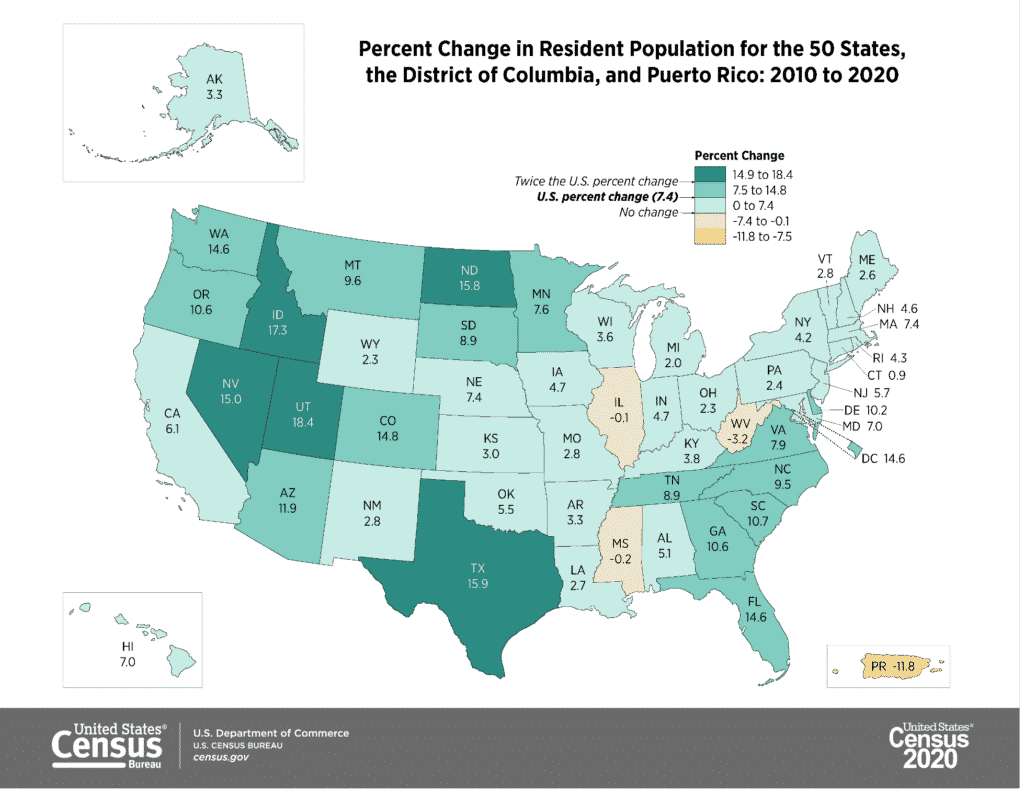During the filming of the American film classic Oh Brother Where Art Thou? Mississippi locations were, according to Joel Coen, “greener than Ireland, an intense emerald green” completely at odds with the brothers’ desired look for the finished film. They used digital techniques to take the green out.
In Census data on population trends, it is clear that Mississippi policymakers should try hard to put the green back by expanding opportunities as much as possible.

Peering at the map of population trends by county above, it’s noticeable that the majority of “green” counties in the South cluster in three states: Florida, Tennessee, and Texas. These also happen to be the three states without a state income tax. Is it coincidental that these states have a lot of not just green but “intense emerald green” counties? Mississippi lawmakers passed major tax reform in 2022- a promising step but obviously Florida, Tennessee, and Texas remain ahead in the game.
Taking the lens back a decade, the picture for Mississippi is also concerning:

Mississippi didn’t rapidly shrink during this period, but it also one of the few states that didn’t grow. Taking the trip back further in time, Mississippi had about 2% of the American population in 1900. In 2020 it was below 1%. This speaks to a long-term migration trend.
In the map below, dark green signifies public school enrollment loss during the pandemic instead of a positive trend in the maps above. No one has darker green than Mississippi, and enrollment did not snap back the following school year. Like everywhere else Mississippi students took quite an academic hit during the COVID-19 disruption.

A few years ago, an uber driver in Western Michigan told me that he moved out of Detroit looking to improve his life. “I’m thinking about moving to Texas though,” he said “I hear that is the land of opportunity.” The Census Bureau data regarding population trends by county show that he was far from alone in drawing this conclusion. This is the sort of reputation that Mississippi can cultivate, and education has a part to play.

This picture above was taken from a micro-school in Florida and captures the sort of opportunities provided by pluralistic K-12 policies. These opportunities are not just for students and families, but also for teachers. Florida lawmakers have supported a variety of strong policies allowing teachers to create their own schools since the 1990s. Ron Matus explained the photograph:
The instructor, Alexa Altamura, adds a dash of math (slice the onion into cubes), a drop of geography (the pink salt is from the Himalayas), a pinch of global trade (tomatoes are originally from Mexico). She folds in a smidgen of anatomy (the role of muscles in chopping), a morsel of chemistry (steam, reduction, the Maillard reaction), a hint of marketing (that stamp in the cheese wax isn’t there by accident). There’s a little history scattered in (the recipe calls for pancetta because ancient Italians used cows for work, not food). And, incredibly, a lick of biology (a pivot into pasta varieties yields mention of black pasta, colored by the ink that squid disperse to escape predators.)
If it looks like the kids and their teacher are all having a blast, it is because they were in fact having a blast. Do you think Altamura had problems getting her students to get back to school? Variety is the spice of life, and if Mississippi had more of it in K-12, you’d have schools to which students would feel anxious to return. Mississippi has educators who could amaze us with their own vision of a high-quality education. What Mississippi students and teachers need is the opportunity to flourish.

